Rome Diary - Part VII
June 22
The residents hosted a BBQ lunch for the BSR staff, in recognition of their services, with particular acknowledgements to Sue Russell, the Deputy Director from Melbourne, who is retiring. I was appointed the task of burning the meat.

Photo: Royal apron for a BBQ at the BSR.
Geraldine, the Residence Manager, could not attend due to illness. Everyone was concerned for her welfare and wishing her a speedy recovery.
The lecture theatre hosted a book launch in the evening. Matthew Sturgis, the author of When in Rome: 2000 years of Roman Sightseeing gave an entertaining talk about how the tastes of tourists to the Eternal City have changed over the centuries. It was a pleasure meeting Matthew and his Australian partner, Rebecca Hosking who runs a gallery in London.
June 23
I broke my resolve to stay focused on Rome and caught an early bus to Siena. Noticed that my bag, purchased in a second-hand shop in Sydney, was branded Tosca, pertaining to the region of Tuscany, where I (and the bag) were heading.
It was noon when I arrived in the centre of this historic hilltop town that shares its emblem, the she-wolf suckling the infant twins, with Rome.

Photo: Siena.
The city was at its peak in the early 1300s, before it was struck by the bubonic plague and then a military siege at the hands of its neighbour, Florence. As a result the decimated city was largely forgotten during the Florentine led Renaissance, and with virtually no rebuilding since, retains its medieval character.
I had left the details of my hotel booking behind, but followed my nose and found the Hotel Moderna located at the base of the hill. I deposited my bag in my room and made my way to the Piazza del Campo.

Photo: Piazza del Campo, Siena.
I sat in the sun sketching the Palazzo Pubblico, enjoying the ambience and letting the heat relieve muscle spasms in my back which I had strained while shifting the BBQ the day previous.

Photo: Ink wash drawings, Palazzo Pubblico , Piazza del Campo, Siena.

Photo: The Tower del Mangia, Siena
I contemplated climbing the exceptionally tall bell tower, but found I still could not stand straight, so I abandoned the Quasi Moto task and lurched instead up the shorter flight of stairs to the council chamber next to it. Here Lorenzetti’s famous fresco cycle, The Allegory of Good and Bad Government, lines three walls. Arguably the first landscape painting of the modern era, it reminded the nine councillors who met under it that the city and the country it occupied depended upon their diligence.

Photo: Ambrogio Lorenzetti, Good Government, 1337-39. Fresco Sala dei Nove, Siena.
The fresco depicting Good Government is divided equally between the urban and rural subject with the city gate providing the artery for a steady flow of industrious citizens between. The oblique angles in the architecture are yet to discover a common vanishing point, however fractional geometric relationships and linear rhythms underpin the composition.
The wall depicting Bad Government is itself the victim of bad management as salt stored in the room underneath seeped up through the wall to seriously damage the fresco.
At the end of the day I passed a procession of men dressed in traditional livery presenting themselves at the church of San Francesco, each carrying the flag of their local neighbourhood.

Photo: Neighbourhood pride at the church of San Francesco, Siena.
This ceremony marks the beginning of an annual bareback horse race called Palio that takes place in the Pizza del Campo on July 2. Each rider competes for the honour of their neighbourhood in a wild race that is older than Lorenzetti’s painting. Support squads could be heard practicing their drumming throughout the afternoon. ...I would be surprised if the gentle, animal-loving St Francis would feel honoured by the spectacle.
24 June
My back improved significantly overnight and I was better able to explore the town.
Cobblestone lanes follow the topography and the unexpected curves and inclines provide surprising views and a jumbled, patchwork effect to vistas of the medieval town.
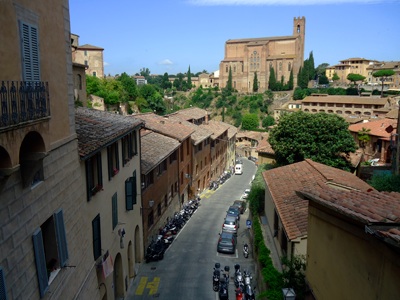
The view down alley ways, particularly those with arches across them, was particularly appealing.
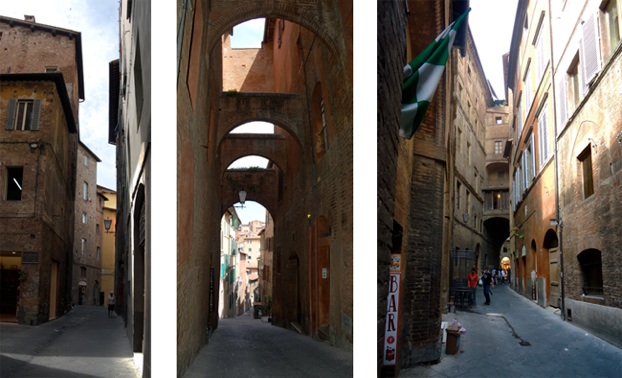
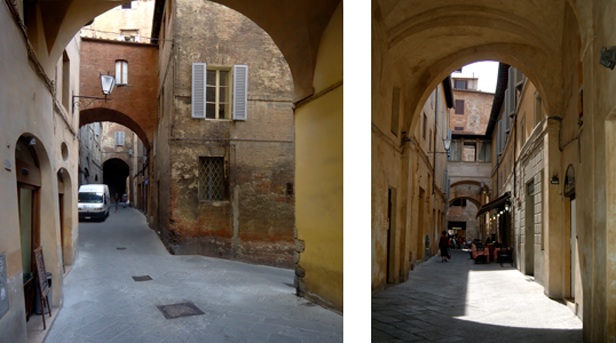
Worked my way up to the Duomo, a cathedral completed in 1205, decorated with bands of black and white marble.
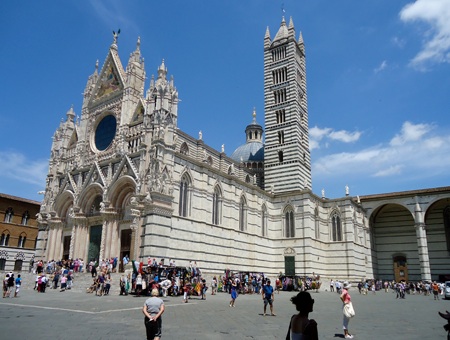
Photo: Siena Cathedral (Duomo) built in the 13th century.
Santa Maria della Scala lines the rear of this square. It was once a hospital, but is now a museum complex, and contains many frescoes and paintings. Behind the foreground activity in the main fresco I noticed background spaces framed by arches, similar to the views I had admired throughout the town.
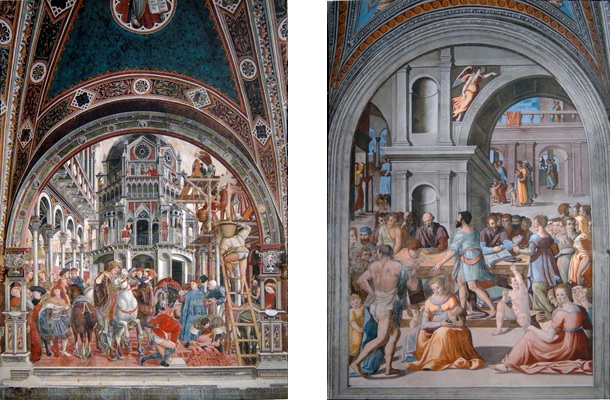
Photos: Domenico di Bartolo, The alms of the Bishop, 1443 (left); Achilles Crogi / John Raffaele Navesi, Payment of wet nursing in cash, 1577 (right); frescoes at S. Maria della Scala.
Santa Maria della Scala was also an orphanage, although a painting of The Massacre of the Innocents by the entrance to the hospital church was disturbing.
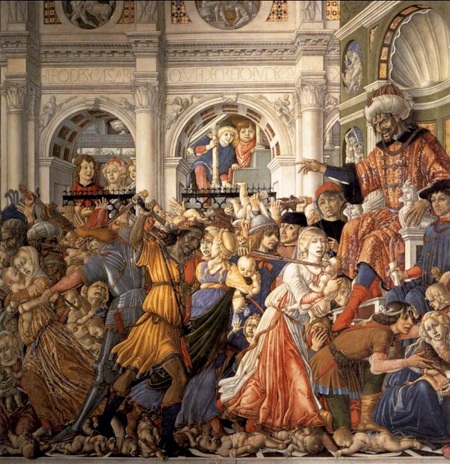
Photo: Matteo di Giovanni, La strage degli Innocenti.
Deep in the bowels of this rambling complex is a dimly lit chapel dedicated to St Catherine, the focus of Cordelia’s research into alternative stigmatics and Sian’s photographic collaboration. Catherine was represented in a reclining statue and swooning in various paintings throughout.
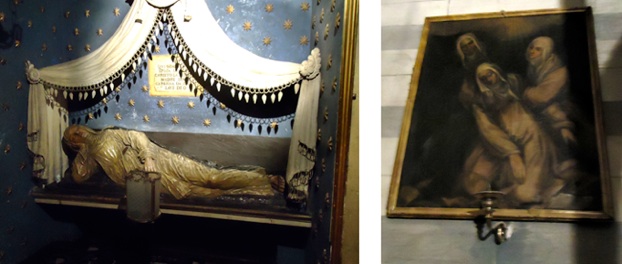
Photo: St Catherine of Siena swoons from invisible stigmata, Santa Maria della Scala chapel.
A knotted rope hanging on a hook was a mystery. Until I recalled Cordelia saying the Dominicans ruled that stigmata could include self-inflicted wounds... Perhaps this is provided for those who might get the urge to self-flagellate and forgot to bring their own whip! A hand-written list of names by the door seemed to suggest a group is still active here. The hands of saints are kept in a glass case nearby. ...Creepy!
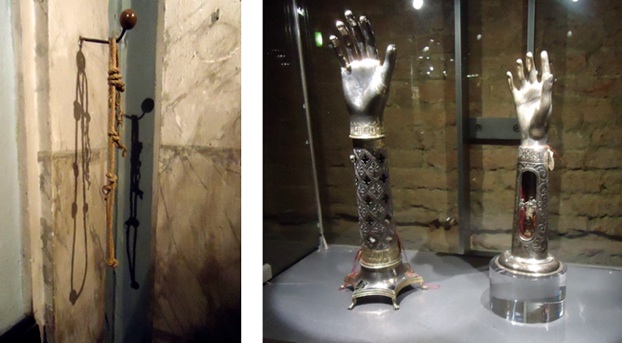
Photos: Knotted rope on a hook, Santa Maria della Scala chapel,
and the arm bones of saints.
Looking at my bus ticket I realised there was not enough time to explore the interior of the Duomo, so headed back to the Piazza del Campo, where barricades had gone up overnight for the Palio. Had a slice of pizza before boarding my bus to Florence.
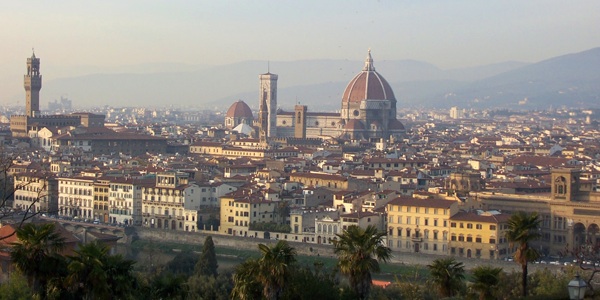
Photo: Florence (View from Piazelle Michelangelo.)
The journey to the city regarded by many as the birthplace of the Renaissance and as one of the most beautiful cities in the world took barely an hour.
Florence is located on the relatively flat banks of the river Arno. Its historical wealth and power is immediately evident in its grand architecture. I found it lacking the character of Siena, and the vitality of Rome, although the hordes of tourists and street-stalls obstructing the view might have been undermining first impressions. I have never seen so many leather handbags and jackets!
For 35 Euros the Hotel Lorena provided a room with a view of the Medici Chapel diagonally opposite and a glimpse of the spire from Brunelleschi’s famous dome behind it (red arrow).
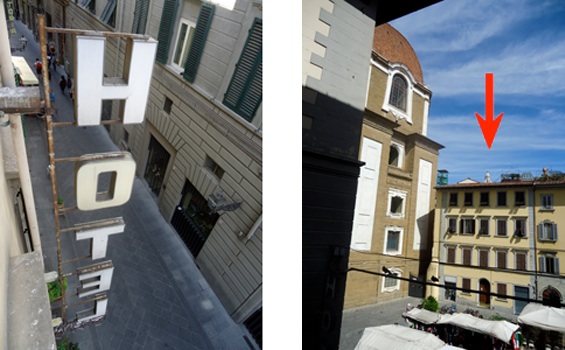
Photos: View from my window at Hotel Lorena, Florence.
I went for a walk through the historical centre. Checked out the baptistry behind the Duomo and the vantage point from which Brunelleschi reportedly painted it in the first picture to use fully rationalised linear perspective (circa 1425). This picture would have included the famous bronze doors that he lost the commission for earlier in his career.
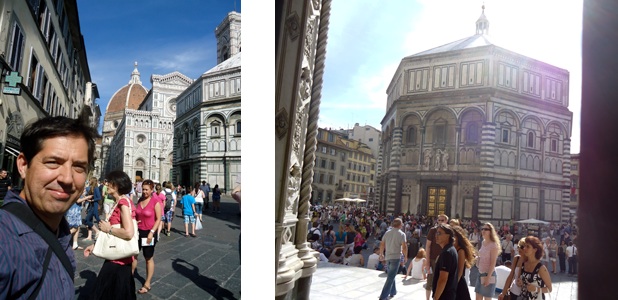
Photos: Santa Maria del Fiore (The Duomo) with dome built by Brunelleschi, and view he painted of the Baptistry with its famous bronze doors.
Then, I made my way to the Piazza della Signoria, where a copy of Michelangelo’s David stands beside the entrance to the city’s Romanesque town hall, The Palazzo Vecchio.

A sculpture beside the giant slayer depicts a man dominating another. Those in the loggia adjacent, continue a violent them.

The Uffizi Gallery is divided into two wings with a street running between. I made an inkwash drawing from the steps of one, of the view through an arch in the wing opposite, while observing a cat-and-mouse contest between street hawkers and police patrols.

The facade enclosing the Uffizi courtyard frames a view of the city on the other side of the river.
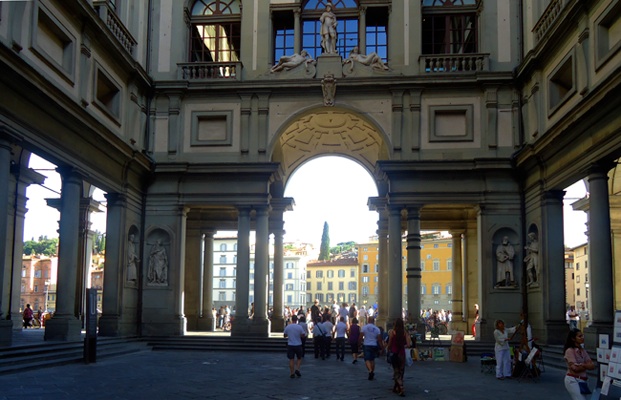
Medieval shops add colour to the bridge crossing the river.
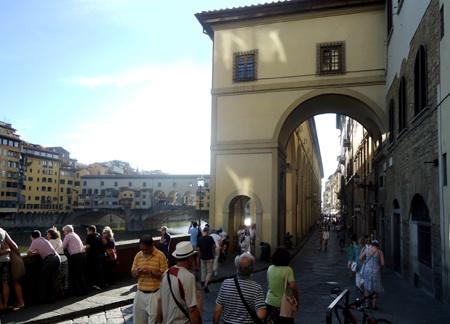
Made my way up the hill to Piazelle Michelangelo, which provides spectacular views of the city, although the entrance was locked by the time I got there. Returned to the Hotel Lorena and concluded my day with an overpriced sandwich and beer in the bar downstairs.
25 June
An early start and pre-booking got me ahead of the crowds at the Uffizi (Thanks to Maria Pia at the BSR), even if they soon caught up with me, as I lingered in one of the world’s greatest collections of paintings!
Highlights include a line of small panels by Filippo Lippi (Predella of the Barbadori Altarpiece c.1437). Modest scale, a reduced pallet, and austere architectural settings utilised in tightly cropped compositions where the tension between isolated parts and the unified whole seems to correlate with the contest between subjective and objective reality.

Photo: Filippo Lippi, Predella of the Barbadori Altarpiece c.1437. Oil on panels.
I was surprised by how much I enjoyed Botticelli, and what seems to be the friction between medieval design and Renaissance illusion. His Annunciation sets the juncture between the divine angel and mortal virgin in an exchange between architectural space and landscape. The focal point is the space between the reaching hands that correlates with the window frame, dividing the interior from the exterior view.
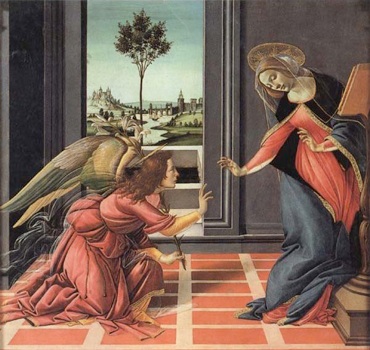
Photo: Sandro Botticelli, The Annunciation, c. 1490. Tempera on panel, 150 x 156 cm.
Leonardo da Vinci’s earlier painting plays with similar issues, expanding the space between the gesturing hands and using a garden setting as the more neutral space between the domestic interior and exterior landscape. As with Botticelli, a pastoral landscape seems to frame the trespassing angel. Its serpentine path leads from the gap in the garden wall, and through the line of cultivated trees that are themselves broken by a view of wilder grandeur as distant mountains engage with dissolving atmosphere and light. The virgin is interrupted while reading which adds the mental realm to the juncture of different spaces.
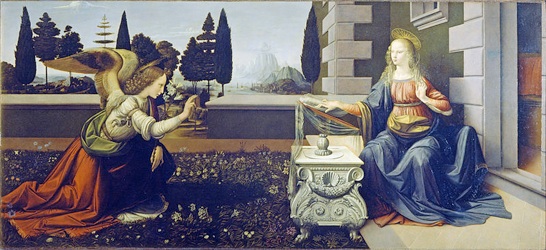
Photo: Leonardo da Vinci, Annunciation, c. 1472. Oil and tempera on panel, 98 x 217 cm.
Mariotto Albertinelli chose the moment after the Annunciation for his painting, Visitation, where Mary shares her secret with her visiting cousin. An arch frames the two women. Despite its imposing scale and graphic boldness, this work emphasises the intimate, with tension concentrated in the space between the profiled faces, the key hole view of the horizon between their embracing arms and the sliver views of the landscape on either side.
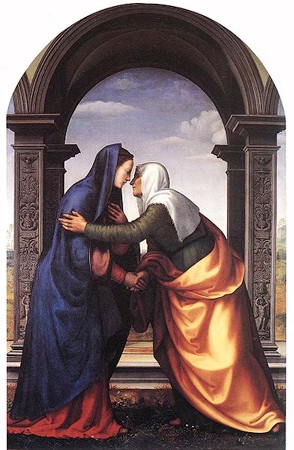
Photo: Mariotto Albertinelli, The Visitation, 1503. Oil on panel, 232 x 146 cm.
Veronese sees how far he can stretch the space between the two protagonists in his Mannerist interpretation of the Annunciation. A centrally located garden and classical architectural setting frames a direct path to the vanishing point, which obstructs the cross canvas exchange between Gabrielle and Mary, requiring a magical cloud to overcome it.

Photo: Paolo Veronese, Annunciation, c. 1555. Oil on canvas, 143 a 291 cm.
Rembrandt’s three self portraits, one as a young man and two of himself older, are inspiring for their mastery of both the illusionary image and the substance paint, which in contrast to the receding depth of perspective, brings a sense of presence to our side of the picture plane.
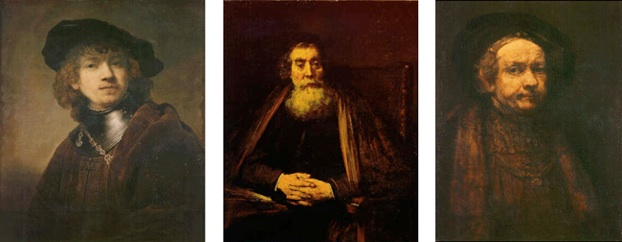
Photos: Rembrandt van Rijn, Self-portrait 1634, c 1665, and c 1669. (oil on panel and canvas).
I appreciated this small painting by Tiepolo with its centrally divided composition, fresh paint and complimentary exchange between classical architecture and wild nature. The arch at the extreme right provides an interesting counterpoint to the foreground drama on the left.
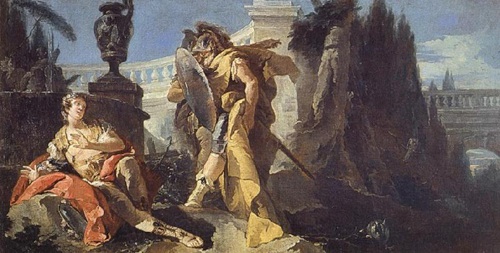
Photo: Giambattista Tiepolo, Rinaldo recognises himself in Ubaldo’s Shield, oil on canvas.
(No photos permitted in the Uffizi so all pics of paintings courtesy of the net.)
I thought I would check out the original Michelangelo sculpture of David at the Accademia Gallery after lunch. With no pre-booking, I joined the queue.
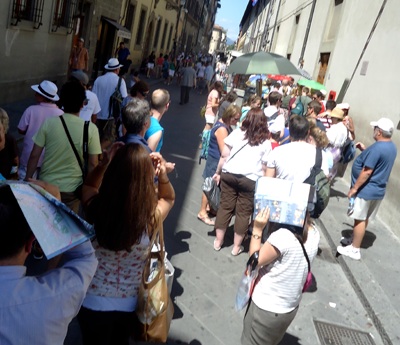
Photo: Queuing outside the Accademia Galleria, Florence
After standing for two hours in the sun I resorted to sitting on the footpath, and was leaning against a wall when a frantic street seller ran up, shoved his art prints behind my back, and took off down the street. Seconds later his partner did the same. He feigned to stroll away casually but was crash tackled in front of me by a helmeted policeman. I don’t think the first guy got very far down the street before the same happened to him. I leaned back instinctively to conceal the prints fearing I could be mistaken for an accomplice, but then an American women began shouting at me convinced I was, so I placed them on the ground next to me and returned to “reading” my book. The indignant American came over to seize the “evidence”, but a local woman blocked her and asked her “why?” I thought the two perspectives were interesting. One assumed anyone targeted by the police was a criminal, the other recognised the hardship faced by poor people outside of the system.
It was after 4 pm and I was still a long way from the entrance, so I accepted the queuing system had failed me and bid farewell to my temporary companions.
All the fast trains to Rome were booked, so I caught a late slow train and finished reading Italo Calvin’s Invisible Cities.
It was a little after midnight when I made my way up a familiar flight of stairs at the British School of Rome.
26 June
Time to pack my bags! It was difficult preparing to leave what had been my home for the past three months. Made a pot of coffee to help get the process going only to commiserate with other residents in the kitchen, going through the same trauma.
A room full of Morandi’s had gone up at the National Museum of Modern Art next door so I postponed the dreary task of packing and enjoyed his subtle colours and sensitive touch. After so many old masters it was great to see something more “modern” still excites me.
It was such a lovely afternoon I decided to make a farewell tour of the city. I walked through the Borghese gardens, down the Spanish Steps, and up to the Trevi Fountain where, despite my usual pragmatism, I tossed a coin in.
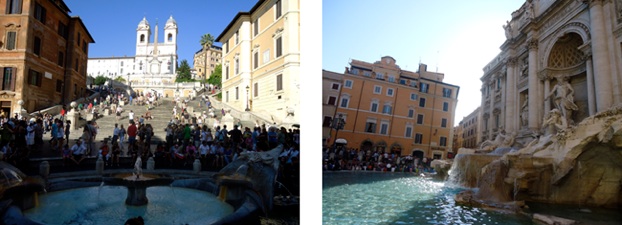
Photos: Farewell tour of Rome. The Spanish Steps and Trevi Fountain.
I climbed the Esqualine hill, passing a military drill in progress.
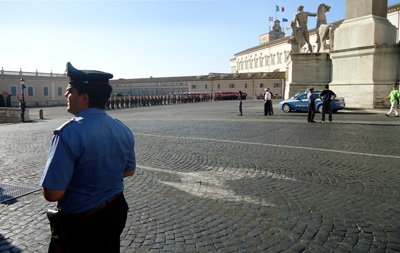
Skirted around the back of the Trajan’s markets and the Imperial Forum and, finding it closed to traffic, marched down the centre of the road to the Colosseum.
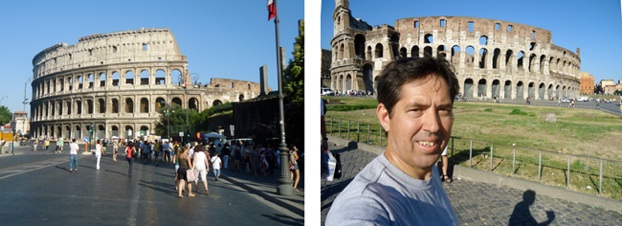
I turned right, passed the Arch of Constantine and through the long shadows cast by the trees and aqueduct on the Palatine. Turned left at the Circus Maximus, and continued on to the Baths of Caracalla. I should have had 45 minutes to enjoy the ruins in the golden light before the scheduled closing time, but the wardens could not be convinced to let me in, so I circled the perimeter and climbed a wall to gain a final view.

Returned to Circus Maximus where even the subway crush seemed to be tinged with nostalgia by virtue of its final passing.

I exited at Piazza del Popolo...
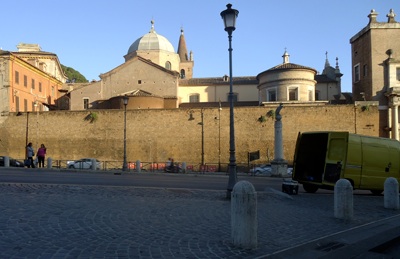
...and made my last hike up the hill and through the gardens, arriving just in time for the dinner bell.
The artists headed out for final drinks after dinner. I intended to have a couple of beers and ended up with a couple of limoncellos as well. By the time we caught a taxi home it was 2 am. I still hadn’t packed my bags, but the drinks seemed to make the task easier. I simply packed the paintings and put everything else into the bin!
27 June
I woke after barely two hours sleep, regretting the limoncellos! Had a quick shower, left a thank you note for the cleaner, made a final scan of the room, and dragged my luggage out to the reception. I was hoping for a few minutes pause, but the car booked for 8 am was already waiting. Alice, Ellen and her husband Sam came down the steps to see me off and before I knew it they were receding figures in the rear window.

Photo: Smiling through the pain. (Photo Alice Bygraves.)
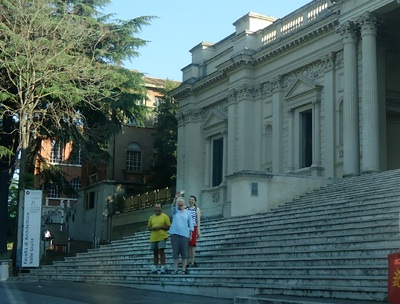
Photo: Arrivederci Roma!
28 June
It was sad to end a once-in-a-lifetime term in Rome, but it was wonderful to return to my family who were waiting to greet me in Sydney.
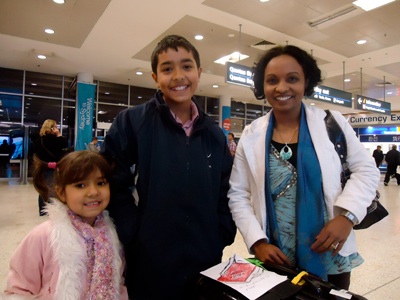
There is no place like Rome, but all roads lead to home!
13 July
I have been home for two weeks adjusting to the cold, and enjoying the school holidays with my family. Sometimes it feels like time stood still and Rome occurred in another dimension. It will probably take a while to digest everything, and for the full impact to be realised, but I am certain the knowledge and new perspectives gained through this residency will stay with me for the rest of my life.
The physical encounter with the Eternal City and its art brought a sense of discovery and presence I would never find through the study of books alone. As a painter, the city was like a theatre set, full of surprising relationships to be found from countless vantage points.
The British School at Rome provided an impressive home base and support team that facilitated this experience; their lecture program adding layers of history and meaning to the visual. Acknowledgements again, to Dr Robert Coates-Stephens and his City of Rome excursions. I was privileged to engage with interesting people across the dinner table each evening, resident academics, artists and visiting guests, who are leaders in their respective fields. These conversations, in addition to the value of the content, expanded my social sphere.
I will always be grateful to the William Fletcher Foundation and to the late Dr “Nick” Matheson whose bequest is responsible for providing this unique scholarship, as well as Mr Barry Pearce for selecting me as its inaugural recipient.
Special thanks goes to Dr Christopher Allen and Michelle Hiscock for their invaluable support. Their visit in Rome and the two days spent sketching with their group in the Forum and down the Appian Way was a highlight of the residency. The visit from Liz Gibson and Gundo and the evening out in the Campus Martius was also a treat that was greatly appreciated.
The General Secretary, Robin Wines, and the Founding Director of the WFF, Trevor Anderson, are wonderful people, who supported me and my family as if we were family, providing maps, loaning books, offering valuable email advice etc. Robin’s laptop kept me in Skype contact with my wife and children, and during my absence Robin and Trevor treated my family with a day trip to Helensburgh and sent me the photos. This was followed by a Mother’s Day excursion to the Little Italy restaurant in Cronulla. Thanks also to Eula Guthrie for her company on that occasion.
My gratitude is also extended to Brian Ladd, Liz Gibson, Christopher, and Robin whose support has included the purchasing of work.
I hope that I am able to justify all this good faith.
I am entering a period as Artist in Residence at Sydney Grammar School. This will conclude with an exhibition opening on August 19, where I hope to express my gratitude to everyone in person.
Grazie e arrivederci!
